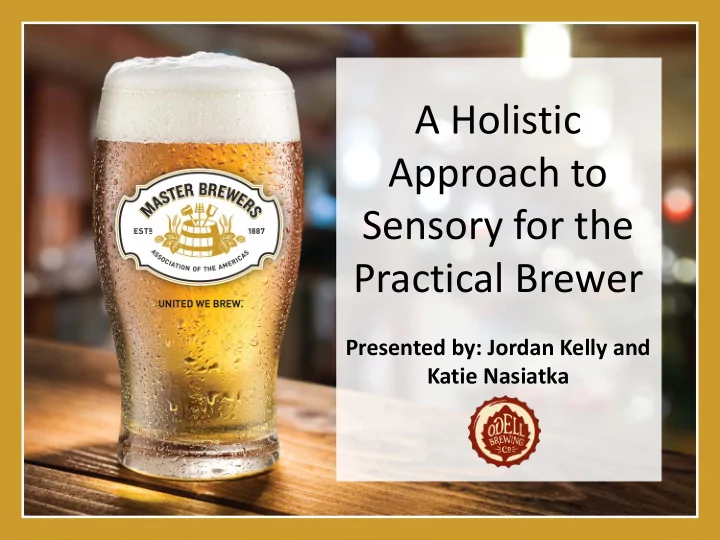

A Holistic Approach to Sensory for the Practical Brewer Presented by: Jordan Kelly and Katie Nasiatka
Who are we? • 110,000 BBLs annually • Mid-size Colorado craft brewery • Sensory/lab team of three
The Proverbial “Rabbit Hole”
The Proverbial “Rabbit Hole” • Dedicated sensory lab • Panel validation • Triangle, duo-trio, tetrad, ascending method of limits testing • Attribute scaling and descriptive analysis • Statistics and statistics software • Training or certifications: Siebel, Cicerone, etc.
Where do I even start?
Building a Practical Sensory Program Collect, Build Set Up Define Analyze and Quality Basic Prioritize Purpose Toolbox Structure Data
Building a Practical Sensory Program Collect, Build Set Up Define Analyze and Quality Basic Prioritize Purpose Toolbox Structure Data
Defining a Purpose • Go or no-go • Overall consistency • Scoring • Identification of defects • Descriptive analysis • Attribute scaling
Defining a Purpose For example, our purpose: • Sensory is the gold standard • Inclusiveness • Guide decision making • Batch consistency and descriptive analysis • Defect identification
Building a Practical Sensory Program Collect, Build Set Up Define Analyze and Sensory Basic Prioritize Purpose Toolbox Structure Data
The Basic Structure 1) Established time intervals of tasting, testing and training 2) Process points of taste testing 3) Place to taste 4) People to taste
The Basic Structure 1) Established time intervals for tasting, testing, and training
The Basic Structure 23-27 °C 2) Process points of taste testing 1) Place to taste 2) People to taste!
The Basic Structure 3) Place to taste 1) People to taste!
The Basic Structure 4) People to taste (your sensory “machines”)
The Basic Structure: A Budget A budget will realistically set the structure.
Building a Practical Sensory Program Collect, Build Set Up Define Analyze and Sensory Basic Prioritize Purpose Toolbox Structure Data
Building a Practical Sensory Program Collect, Build Set Up Define Analyze and Sensory Basic Prioritize Purpose Toolbox Structure Data Leverage your existing resources and materials!
Leverage Existing Resources and Materials 1. Space 2. Glasses 3. Tasters 4. Training materials 5. Sensory standards 6. Data Recording
Leverage Existing Resources and Materials
Building a Practical Sensory Program Collect, Build Set Up Define Analyze and Sensory Basic Prioritize Purpose Toolbox Structure Data
Build Your Sensory Toolbox • Training • Triangle testing • Blind tasting • Scoring systems • Statistical tools • Panelist profiles • Holistic grasp on individual strengths and unique descriptors
Build Your Sensory Toolbox
Build Your Sensory Toolbox
Build Your Sensory Toolbox
Building a Practical Sensory Program Collect, Build Set Up Define Analyze and Sensory Basic Prioritize Purpose Toolbox Structure Data Leverage your strengths!
Leverage Your Strengths Strengths Weaknesses Strong quality foundation • No ASBC MOA validated • Long-time employees, • panel experienced in tasting our beer • Sensory lab with segregated Committed, interested tasters booths • (3-5 daily panelists) • Statistical software A budget • • Sensory technology/data Culture • – Resourceful, “let’s try it!” input – Learning and education • Dedicated sensory – Inclusive and employee owned employee Small Team = full picture • perspective
Leverage Your Strengths
Building a Practical Sensory Program Collect, Build Set Up Define Analyze and Sensory Basic Prioritize Purpose Toolbox Structure Data
Collect, analyze and prioritize data • Start with low-hanging fruit • More is better… to a point – Collect actionable data • Prioritize problem areas • Return to “the goal”
Collect, analyze and prioritize data
Collect, analyze and prioritize data Collect Analyze Not Acceptable Acceptable Perfect! Improvement? Retest Not Investigation Acceptable Acceptable Investigation
Building a Practical Sensory Program Collect, Build Set Up Define Analyze and Sensory Basic Prioritize Purpose Toolbox Structure Data Avoid Sensory Pitfalls
Avoid Sensory Pitfalls • Well, try your best • Minimize bias • Separation of quality, brewing, and financial interests in the sensory space • Focusing on areas not relevant to your beer • Doing too much too soon • Alienating potential assets • Competitive or hostile environments
Long story short… Any brewery, of any size can build and fit a sensory program to their needs!
Thank you! Questions?
Recommend
More recommend